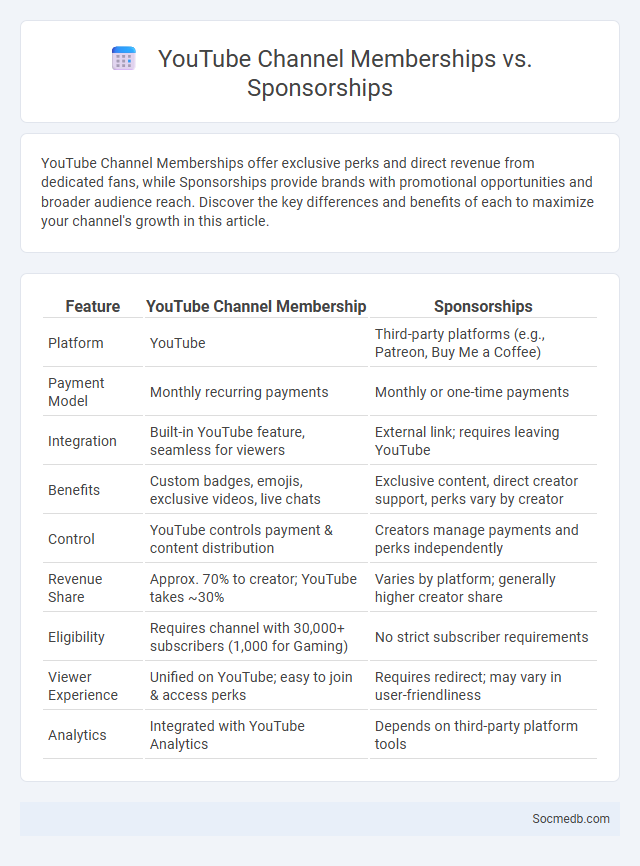
Photo illustration: YouTube Channel Membership vs Sponsorships
YouTube Channel Memberships offer exclusive perks and direct revenue from dedicated fans, while Sponsorships provide brands with promotional opportunities and broader audience reach. Discover the key differences and benefits of each to maximize your channel's growth in this article.
Table of Comparison
| Feature | YouTube Channel Membership | Sponsorships |
|---|---|---|
| Platform | YouTube | Third-party platforms (e.g., Patreon, Buy Me a Coffee) |
| Payment Model | Monthly recurring payments | Monthly or one-time payments |
| Integration | Built-in YouTube feature, seamless for viewers | External link; requires leaving YouTube |
| Benefits | Custom badges, emojis, exclusive videos, live chats | Exclusive content, direct creator support, perks vary by creator |
| Control | YouTube controls payment & content distribution | Creators manage payments and perks independently |
| Revenue Share | Approx. 70% to creator; YouTube takes ~30% | Varies by platform; generally higher creator share |
| Eligibility | Requires channel with 30,000+ subscribers (1,000 for Gaming) | No strict subscriber requirements |
| Viewer Experience | Unified on YouTube; easy to join & access perks | Requires redirect; may vary in user-friendliness |
| Analytics | Integrated with YouTube Analytics | Depends on third-party platform tools |
Introduction to YouTube Monetization Options
YouTube offers multiple monetization options to help you earn revenue from your content, including AdSense ads, channel memberships, Super Chat, and merchandise shelf integration. By enabling monetization features through the YouTube Partner Program, creators can tap into ad revenue, fan funding, and direct sales to support their channels. Understanding how each method works allows you to maximize your income potential while growing your audience and engagement on the platform.
What is YouTube Channel Membership?
YouTube Channel Membership is a feature that allows creators to offer exclusive perks to subscribers who pay a monthly fee. Members gain access to special badges, custom emojis, members-only videos, live chats, and other unique content that enhances community engagement. This monetization tool helps creators generate recurring revenue while providing fans with a more personalized experience.
Understanding YouTube Sponsorships
YouTube sponsorships involve partnerships where brands pay content creators to promote products or services in their videos, leveraging the creator's audience for targeted marketing. Sponsors often seek creators with substantial engagement metrics such as high views, watch time, and subscriber count to maximize campaign effectiveness. Understanding contract terms, disclosure guidelines per FTC regulations, and aligning brand values with the creator's content are critical factors for successful YouTube sponsorship engagements.
Key Differences: Memberships vs Sponsorships
Memberships offer exclusive access to content or perks within a defined community, often requiring recurring payments, while sponsorships involve brands supporting creators or events in exchange for promotional exposure. You benefit from memberships by receiving personalized engagement and tailored experiences, whereas sponsorships focus on broader brand visibility and audience reach. Understanding these distinctions helps optimize your social media strategy for growth and monetization.
Revenue Potential: Comparing Earnings
Social media platforms generate revenue through diverse streams such as advertising, sponsored content, and subscription models, with Facebook leading in ad revenue, earning over $115 billion in 2023 alone. Instagram and TikTok follow closely, leveraging influencer marketing and branded content to drive substantial earnings. YouTube's premium subscriptions and ad rev share provide creators with significant income opportunities, highlighting the platform's robust revenue potential compared to others.
Audience Engagement and Community Building
Maximizing audience engagement on social media requires crafting content that resonates deeply with your target demographic, encouraging active participation through comments, shares, and likes. Building a loyal community hinges on consistent interaction, prompt responses to feedback, and fostering a sense of belonging among followers. By leveraging analytics and personalized communication, you can strengthen your brand's presence and cultivate meaningful relationships that drive long-term growth.
Control and Content Flexibility
Social media platforms offer extensive control features enabling users to customize privacy settings, manage audience access, and moderate interactions effectively. Content flexibility allows creators to publish diverse media formats such as text, images, videos, and live streams, adapting messages to various target demographics. Advanced algorithms support tailored content distribution, enhancing engagement and maximizing user reach across multiple social networks.
Eligibility Requirements and Set-Up
Setting up social media accounts requires users to meet specific eligibility requirements, including age restrictions commonly set at 13 years or older, and compliance with the platform's terms of service. Verification steps often include providing a valid email address, phone number, or government-issued ID to ensure account authenticity and enhance security. Proper account configuration involves selecting privacy settings, enabling two-factor authentication, and linking other social media profiles to optimize user engagement and protection.
Long-Term Sustainability and Growth
Long-term sustainability and growth in social media rely on continuous innovation and user-centric platform adaptations to maintain engagement and relevance. Leveraging advanced data analytics and AI-driven personalization enhances content delivery, fostering deeper community connections and retention. Strategic investments in privacy, security, and ethical data practices build user trust and regulatory compliance, ensuring stable platform evolution.
Which Model is Right for Your Channel?
Choosing the right social media model depends on your channel's goals, audience demographics, and content type. Influencer marketing suits brands seeking authentic engagement, while paid advertising offers precise targeting and scalability. Organic growth focuses on community building and long-term loyalty, making it ideal for channels prioritizing sustained interaction.
 socmedb.com
socmedb.com